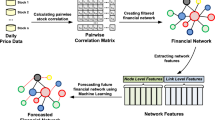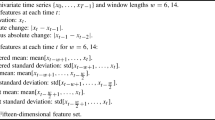Abstract
We study an indicator of financial instability based on the computation of the decay rate for the propagation of a given market shock. The rate of variation through time of an initial perturbation of the price process enables us to understand if such a shock will be rapidly absorbed or, on the contrary, it will be amplified by the market. The indicator combines non-linearly volatility, leverage and covariance between leverage and price and is model-free. It provides an early warning indicator of instability for a given high frequency financial time series. A new consistency theorem for the estimator of each component of the proposed indicator is proved. The properties of the indicator are investigated numerically under the CEV model and empirically using tick-by-tick data of the S&P 500 index futures.








Similar content being viewed by others
Notes
The last factor is shown to be related to the volatility of volatility in the paper.
In Example 2.4 Barucci et al. (2003) the given expression for the feedback rate in the case of the CEV model contains a mistake due to an uncorrect change of variable. However, the CEV model is not further investigated in that paper, thus the error does not affect at all the results presented therein.
The prime stands here for the first derivative with respect to the level \(x_t\).
Note that these conditions also imply that \(M^2/n \rightarrow 0\), as required by Theorem 3.2.
Note that this corresponds to the Black-Scholes case.
References
Adrian T, Boyarchenko N, Giannone D (2017) Vulnerable Growth, Staff Reports, No 794 (revised), Federal Reserve Bank of New York
Aït-Sahalia Y, Jacod J (2014) High-frequency financial econometrics. Princeton University Press, Princeton
Barucci E, Malliavin P, Mancino ME, Renò R, Thalmaier A (2003) The price-volatility feedback rate: an implementable mathematical indicator of market stability. Math Finance 13:17–35
Bates D (1996) Testing option pricing models. In: Maddala GS, Rao CR (eds) Statistical methods in finance, vol 14. Handbook of statistics. Elsevier, Amsterdam, pp 567–611
Bekaert G, Wu G (2000) Asymmetric volatility and risk in equity markets. Rev Financ Stud 13:1–42
Bussiere M, Fratzscher M (2006) Towards a new early warning system of financial crises. J Int Money Finance 25(6):953–973
Celik AE, Karatepe Y (2007) Evaluating and forecasting banking crises through neural network models: an application for Turkish banking sector. Expert Syst Appl 33(4):809–815
Curato IV, Sanfelici S (2015) Measuring the leverage effect in a high frequency framework. In: Gregoriou GN (ed) The handbook of high frequency trading. Elsevier, Amsterdam, pp 425–446
da Fonseca EL, Ferreira FF, Muruganandam P, Cerdeira HA (2013) Identifying financial crises in real time. Phys A 392:1386–1392
Danielsson J, Valenzuela M, Zer I (2016) Learning from history: volatility and financial crises. Finance and Economics Discussion Series 2016-093. Board of Governors of the Federal Reserve System, Washington. https://doi.org/10.17016/FEDS.2016.093
Deghi A, Welz P, Zochowski D (2018) A new financial stability risk index to predict the near-term risk of recession. Published as part of the Financial Stability Review of the European Central Bank
Demyanyk Y, Hasan I (2010) Financial crises and bank failures: a review of prediction methods. Omega 38(5):315–324
Douady R, Kornprobst A (2018) An empirical approach to financial crisis indicators based on random matrices. Int J Theor Appl Finance 21(3):1–19
Ericsson NR (2016) Eliciting GDP forecasts from the FOMC’s minutes around the financial crises. Int J Forecast 32(2):571–583
French KR, Schwert GW, Stambaugh R (1987) Expected stock returns and volatility. J Financ Econ 19:3–29
Fuertes A-M, Kalotychou E (2007) Optimal design of early warning systems for sovereign debt crises. Int J Forecast 23(1):85–100
Grilli R, Tedeschi G, Gallegati M (2015) Markets connectivity and financial contagion. J Econ Interact Coord 10(2):287–304
Guégan D, Ielpo F (2008) Flexible time series models for subjective distribution estimation with monetary policy in view. Bruss Econ Rev 51(1):79–103
Inkaya A, Yolcu Ocur Y (2014) Analysis of volatility feedback and leverage effects on the ISE30 index using frequency data. J Comput Appl Math 259:377–384
Jiang ZQ, Zhoua WX, Sornette D, Woodard R, Bastiaensen K, Cauwels P (2010) Bubble diagnosis and prediction of the 2005–2007 and 2008–2009 Chinese stock market bubbles. J Econ Behav Organ 74(3):149–162
Kunita H (1988) Stochastic flows and stochastic differential equations. Cambridge University Press, Cambridge
Malliavin P, Mancino ME (2002a) Instantaneous liquidity rate, its econometric measurement by volatility feedback. CRAS Paris 334:505–508
Malliavin P, Mancino ME (2002b) Fourier series method for measurement of multivariate volatilities. Finance Stoch 4:49–61
Malliavin P, Mancino ME (2009) A Fourier transform method for nonparametric estimation of volatility. Ann Stat 37:1983–2010
Malliavin P, Thalmaier A (2006) Stochastic calculus of variations in mathematical finance. Springer, Berlin
Mancino ME, Sanfelici S (2008) Robustness of Fourier estimator of integrated volatility in the presence of microstructure noise. Comput Stat Data Anal 52:2966–2989
Mancino ME, Recchioni MC, Sanfelici S (2017) Fourier–Malliavin volatility estimation: theory and practice. Springer briefs in quantitative finance series. Springer, Berlin
Niemira MP, Saaty TL (2004) An analytic network process model for financial crises forecasting. Int J Forecast 20(4):573–587
Recchioni MC, Tedeschi G (2017) From bond yield to macroeconomic instability: a parsimonious affine model. Eur J Oper Res 262:116–135
Sornette D, Johansen A (2010) Shocks, crashes and bubbles in financial markets. Bruss Econ Rev 53(2):201–253
Stekler H, Symington H (2016) Evaluating qualitative forecasts: the FOMC minutes, 2006–2010. Int J Forecast 32(2):559–570
Van den Berg J, Candelon B, Urbain JP (2008) A cautious note on the use of panel models to predict financial crises. Econ Lett 101(1):80–83
Acknowledgements
We are indebted to Prof. Anne Opschoor and two anonymous referees for their helpful and constructive comments.
Author information
Authors and Affiliations
Corresponding author
Additional information
Publisher's Note
Springer Nature remains neutral with regard to jurisdictional claims in published maps and institutional affiliations.
Rights and permissions
About this article
Cite this article
Mancino, M.E., Sanfelici, S. Identifying financial instability conditions using high frequency data. J Econ Interact Coord 15, 221–242 (2020). https://doi.org/10.1007/s11403-019-00253-6
Received:
Accepted:
Published:
Issue Date:
DOI: https://doi.org/10.1007/s11403-019-00253-6




